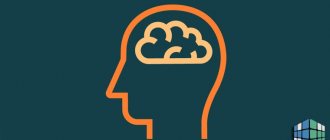- KtoNaNovenkogo
- FAQ
- Are you here
May 10, 2020
- Mentality (mental) is...
- Illustrative examples
- Types of mentality
- What is mental health
- Signs of a mental disorder
- How to treat it
- Conclusion
Hello, dear readers of the KtoNaNovenkogo.ru blog. There are words and terms that most of us understand only in general terms. But often this is not enough.
Today I want to draw attention to such words - mental and mentality, and explain their essence in simple words.
To some they may seem connected with something mystical (such as the astral body), but here everything is mundane and connected with ordinary people, like you and me.
Moreover, in this publication we will talk not only about mentality in general, but also about the problems of mental health, which not everyone is fine with. And, of course, we will touch upon the issue of identifying mental disorders and their treatment.
Mentality (mental) is...
The word “mentality” translated from Latin (“mens”) means mind, disposition of the soul, consciousness , way of thinking. In the modern explanatory dictionary, this concept is synonymous with the term “mentality” (from the Latin mentalite - mental).
Both are deciphered as a plexus of mind and feelings, reflected in the complex of mental and spiritual attitudes of an individual person or an entire group of people.
In simple words , mentality is the prism through which a person looks at the world. It contains moral values, a set of psychological and behavioral reactions, adaptation features, upbringing, attitude towards religion, and culture.
It is important to note that the mentality of an individual is the experience of many generations of his family, nation, country, and therefore is a mixture of the deep, collective unconscious and individual consciousness.
Mental means mental or psychic.
From the point of view of psychology , mentality is a reflection of the contents of a person’s psyche: in what categories he thinks, how he interacts with the environment and what kind of life he leads. Habits, actions and actions speak about mentality.
The determining factor is the individual’s environment – family and society.
What does “mental” mean in philosophy: there is no specific definition of this concept, since such a category does not exist in the context of this paradigm. However, some theories, implying mentality, speak about the spiritual mood of individual social groups.
Mentality and mentality - differences
Mentality is considered the basis, the core of the culture of the people. Mentality is a way of seeing the world in which thought is associated with emotions. Unlike mentality, worldview has universal human significance, and mentality affects any social strata and historical times. Mentality is a prerequisite for the emergence and existence of a worldview.
What is the difference between mentality and mentality? Worldview is a culture that belongs to a certain social group, it is expressed through a way of thinking, reflected in the unconscious emotional and sensory experience in the form of customs, traditions, religion, philosophy and language. Mentality is a broader concept that describes a way of thinking as such. And mentality is a more specific definition, which in general terms describes the specifics of phenomena.
Currently reading: 9 rules for women, the observance of which guarantees success in relationships
Illustrative examples
What is mentality using simple examples.
- In Russia, at the beginning of every spring, Maslenitsa is celebrated: pancakes are baked for a week, then festivities are held, during which an effigy is burned, which symbolizes farewell to winter. In India, they don’t know about this and, perhaps, its inhabitants would twist their heads if they heard about such a tradition.
- Russian platforms are filled with people hugging and kissing goodbye. In France, such behavior at railway stations is strictly prohibited - you can even get a fine. And all because their platforms were once very narrow, and those hugging interfered with the movement of others.
- If they come to visit you, then most likely, as a sign of hospitality, you will offer them tea with something tasty, or maybe you will set a rich table with something stronger. In China, a mug of tea is served to a guest instead of the words “Isn’t it time for you to go home?” This is what different mentality means.
Types of mentality
If you settle a group of people on a desert island: they will settle down, they will have their own rules and norms of interaction, values, views on certain events within their society and outside it.
Subsequent generations will adopt their worldview: this is how the mental connection between people of different times is historically formed.
There are different types of mentality :
- by the type of structure of society - people of the Middle Ages had a different worldview from modern residents;
- by race (Asians, Europeans);
- gender mentality (female, male) – women are more inclined to demonstrate their emotions, males are more likely to keep their experiences to themselves;
- age (children, teenagers, adults, old people) – childish infantility and old age wisdom;
- by religious beliefs (Buddhists and Catholics think differently);
- by level of intelligence: intelligentsia, peasants - if you look at them in a restaurant, you can see a significant difference in behavior at the table.
It cannot be argued that mentality is a phenomenon characterized by constancy. The historical change in mentality over time can be represented in the form of the game “Broken Telephone,” when people pass a word or gesture to each other in a chain.
At the same time, everyone brings something of their own, and the last participant demonstrates something completely different from what was originally asked. Therefore, the worldview of modern people is radically different from those who lived several centuries ago.
What is mental health
Mental health is a concept that characterizes the internal state, reflecting the emotional and mental well-being of a person, the absence of mental problems.
We are talking about a spiritual or mental level of health, indicating psychological maturity. What is mental health ?
- integrity of mind and body;
- the presence of healthy self-criticism (I know what is good and what is bad, I comply with the law and moral principles);
- constancy of one’s own identity (I know who I am, what I am, why I am);
- lack of internal tension (fears, anxieties, prolonged mental suffering);
- harmony with yourself and the world around you - satisfaction from relationships with people and within yourself;
- the ability to plan, set goals and achieve them;
- good mood, optimism;
- control over your behavior, the ability to consciously change it;
- calmness, confidence.
If the mental level of an individual is, as they say, “in order,” then he has the opportunity to maximize his potential - to actualize his inclinations and turn them into talents.
Such a person has a high degree of stress resistance, therefore he easily adapts to changes in the environment and successfully copes with difficulties. A person’s work activity brings him pleasure, and at the same time represents a quality contribution to society.
Features of energy exchange in men and women
The mental connection between a man and a woman is formed through the exchange of energy. A woman is charged with energy from below, and a man is charged from above. To translate the received energy into life, a representative of a strong character must receive a kind of push of feminine power. In turn, a woman is a capsule of power, and does not have the ability to transform it into reality. She simply gives it away, and in return receives energy after a relationship with a man.
Energy exchange occurs constantly between two opposite sexes.
When a boy is born, he has a mother who envelops him with her love. Then he grows up and meets women along the way with whom he begins relationships. This is how the same astral connection between people is formed. In every woman, a man will look for a source of strength that will help him realize himself.
During a relationship, a man and a woman are strongly energetically connected. At this time, a woman gives herself to her partner not only physically, but also mentally. She shows her feminine strength in caring, helping and supporting him in everything. By receiving power, a representative of the stronger sex becomes able to create and create something around him, to be active, thereby fulfilling his purpose in life.
A strong mental connection between lovers is formed only when the man returns the received feminine power.
Having received the required amount of energy, which contributes to his success, a man must return part of the acquired strength to his companion. This is very easy to do - a man gives his beloved gifts, attention and care. Don’t be greedy; a good return will inspire your companion to give back her feminine power again. This creates an endless cycle that will allow the couple to exist in harmony.
Signs of a mental disorder
Human life is filled with unexpected difficulties and negative phenomena that can be difficult to cope with.
It’s good when a person has flexible thinking, is able to adapt to circumstances, without focusing on his suffering due to failures. But often in such situations there are simply not enough internal resources: then homeostasis in the body (what is that?) is disrupted, which is a mental disorder.
Mental illnesses are disorders at the mental level, manifesting themselves in the form of neurotic symptoms (we are talking about initially mentally healthy people).
When a person is faced with force majeure circumstances that he cannot bypass, like water bypassing stones, the following happens: conscious or unconscious disagreement with the situation is resistance. And as we know from physics lessons, any resistance gives rise to tension, which grows every day.
Excessive stress is a large amount of mental energy that requires release.
And she finds it in the form of the following symptoms of mental disorder:
- a person feels causeless anxiety - anxiety;
- he either cries or laughs - his mood changes very often during the day;
- either you constantly want to sleep, or it is not possible to fall asleep;
- attacks of aggression are replaced by depression;
- reactions become inadequate: irritability over trifles, excessive sensitivity, vulnerability;
- a person may experience a feeling of shame, guilt - reproach himself for his condition, but not know how to change it;
- mild anxiety, which was initially, takes the form of panic attacks and various phobias (fear of open space, knives, loneliness, etc.);
- emotional outbursts lead to the body becoming depleted: a feeling of chronic fatigue appears;
- mental functions suffer - attention, thinking, memory, logic, etc.;
- gradually the circle of contacts with society narrows (the individual is embarrassed to appear “like this” in public - in case they take him for a crazy person), only family members remain nearby.
Man in the worldYaroslav Vsevolodovich Mikhailov, 2010
1.3.2. Effective Thinking Strategy
Thinking, which we called effective, is a way of thinking in which thought finds the correct view on the subject of thinking, develops a reliable product of thinking, or concludes that it is impossible to obtain it.
A. Centripetalism is a key characteristic of effective thinking.
The thinking subject operates with a subject information base (Fig. 1.3.1), which includes information that is closely related to the subject of thinking, as well as other, peripheral information that has a weak connection with it.
Peripheral information zones of various objects (objects) intersect due to the universal interconnection of phenomena in the world. Complete information about the item is contained in the item itself. Let's call this information the essence of the subject.
Thinking about an object is always associated with reasoning about it on the basis of available information, which can relate to both internal and external zones. If thought goes to the periphery of the subject base, to zones that carry little information about the subject, and perhaps belong to a greater extent to other subjects, then such thinking means moving away from the main, most important, determining thing, and we will call it centrifugal.
The result is a false opinion.
Centripetal thinking is another matter
thought moves through the central zones and strives to penetrate into the essence of the subject. Such a thought focuses on the main, most important, defining, discarding the secondary as leading away from the essence. At the limit, we have the identification of the thinking “I” with the object of thought and entry into its objective self-essence.
There are ways of penetration of thought into the essence of an object, for which a psychoenergetic contact is established between the subject and the object of thought, during which the thinking mind, identifying itself with the object, feels it as itself and in this way explores the object. These techniques are called methods of identification or identification. We do not encourage the interlocutor to master these methods, but we show the condition for effective thinking, leading to correct decisions: effective thinking is subject-centripetal.
The absence of a central information base prohibits judgment on the subject. First you need to prepare such a base, and then start thinking.
This is exactly what little children do, whom we consider foolish. A child’s thinking is concrete and necessarily connected with real objects that he has learned through personal experience. He cannot think in relation to unfamiliar objects. The child initiates the thinking process in himself, imitating adults. The upbringing of children who are deaf-blind and mute from birth shows that they do not begin to think until their existing sense organs provide them with real objective experience.
Growing up, a person separates thinking from the essence of objects, moving the mind into peripheral information zones. The habit of centrifugal thinking is reinforced, which is greatly facilitated by secular education, and this leads people to erroneous opinions.
Human life is built on the basis of decision making. Decisions that are adequate to the essence of life require a reliable central information base.
Here is a problem of problems and a question of questions. This is what our book is dedicated to. Choosing the right strategy and tactics in life is extremely difficult. And what does correctness mean in such a choice? Everyone considers their preference to be correct, which they rarely question. However, the results of human activity, including the results of life, are determined by the extent to which human actions are adequate to the laws of existence. An analogy with street traffic is appropriate here: strict adherence to the rules significantly reduces the risk of misfortune; violation of them leads to trouble. It is clear that what really matters is not what a person thinks about following the rules, but how he fulfills them, but actions depend on point of view. Consequently, it is not indifferent which views one holds. It’s the same in life. The strategy and tactics of life must correspond to the laws of existence and the purpose of man in it. Then they are beneficial for man. Otherwise, a person (also society) becomes a victim of his own behavior, no matter what he imagines about himself and the world.
In principle, correct behavior is possible even without an understanding of life due to the acquired correct traditions, but in everyday life this occurs as a rare exception, because a person is not perfect. But its potential is enormous. Reason gives him special opportunities, including allowing him to understand existence and himself in it, subject to effective thinking, the key point of which is centripetality.
Ineffective centrifugal thinking should not be confused with abstract thinking. The latter means the absence of a real object, but in relation to a fictional object one can think both centrifugally and centripetally. For example, when solving a mathematical problem, we are not dealing with a living object, but the information zones are fixed in the condition, and it is necessary to determine, first of all, which data are objectively important and which are insignificant, because excess misleading information can be deliberately introduced into the condition.
Understanding the essence of effective thinking, unfortunately, does not mean its “automatic” application in practice, since habits learned in childhood and reinforced by everyday experience offer strong resistance. Effective thinking must be persistently trained, turning it into the only habitual way. In this regard, we recall the aphorism of Pythagoras: “Adopt for yourself only that way of life that your mind has recognized as the best, and habit will make it most pleasant for you.”
B. The right to paradox
In the process of cognition, logic is of great importance. Formal logic establishes the rules for obtaining “inferential knowledge” that follows from the previous one. It is generally accepted that violation of these rules leads to errors or absurdity. Thinking carried out within the framework of formal logic is limited by its framework. However, life does not fit into the shackles of formality, presenting paradoxical situations to the world. Reason will not make revolutionary discoveries, will not find the best of the best and will not find the Truth if it is strictly formalized.
Here we want to be understood correctly. This is not about a deliberate violation of the rules of formal logic, but about replacing them with the rules of life logic, which do not always correspond to speculative logical schemes. The mental process must correspond to the realities of the world, and not to the dogmas of formality. He (MP) has the right to be paradoxical, although he is not necessarily one.
Effective thinking allows for paradox.
Consequently, his conclusions may be completely unexpected, surprising, divergent
with generally accepted views that do not fit into known patterns and at first glance contradict common sense.
Science came to understand the need for paradoxical thinking only in the 20th century. The outstanding Danish physicist Niels Bohr expressed the idea of paradoxical thinking with the question: “Is this idea crazy enough to be true?”
Modern scientific consideration of problems requires
the simultaneous
acceptance of incompatible mutually exclusive phenomena in their unity. So physics established the concept of the electron as a particle and a wave. She was forced to accept such a paradoxical position, since the experiment, and therefore life itself, irrefutably testified to this. Today the fact of wave-particle duality is generally accepted and does not confuse anyone. Another thing is surprising: why are people who accept one paradox unable to accept another? Why is it difficult for many to recognize the Christian dogma of the Trinity, that is, the simultaneous existence of God as Father, Son and Holy Spirit? However, the answer to this question was given above (see 1.3.1).
Let's look at another example. There are people who believe in fate, who believe that everything is predetermined and what will happen cannot be avoided. Others, on the contrary, argue that the future is not determined, but depends on how people act. Within the framework of formal logic, these positions are not compatible. But paradoxical thinking connects them without difficulty. A. S. Pushkin brilliantly demonstrated this in the poem “Song of the Prophetic Oleg”: the old magician predicts Oleg’s death “from his horse.” (Here it is, fate!) After many years, Oleg remembers the magician’s prediction, finds out that his beloved horse has died, and goes to honor his ashes. A snake crawls out of the horse’s ashes, bites Oleg, and he dies. Thus, fate is present (it is predicted), but Oleg creates it with his actions, so everything depends on him and is done according to his will. From this it is clear that human free will does not contradict fate as the predestination of existence. This is the paradoxical conclusion of A.S. Pushkin and ours together with him.
B. Thinking in discrete and continuous images
The thinking mind, reflecting reality in consciousness, creates models of phenomena based on information delivered by the organs of perception and instruments that probe the world around us within the narrow limits of their capabilities, snatching individual fixed areas from the endless natural diversity. This worldview encourages the creation of discrete (discontinuous) models of phenomena and events. A discrete understanding of the world is also facilitated by the desire to structure reality in order to better understand it, highlight the typical, find the essential, and discard the secondary. This creates a specific way of thinking in which the mind asserts discrete ideas about reality. Let us give examples: temperaments (sanguine, choleric, phlegmatic, melancholic); leadership styles (authoritarian, democratic, passive); assessments (excellent, good, satisfactory, unsatisfactory), etc. When thinking in discrete images, people tend to operate with gradations and opposites, not paying attention to the intermediate spectrum of phenomena. For example, they consider nature in the categories of “living” and “non-living” and try to find the line between them, which, perhaps, does not exist. This also includes divisions into good and evil, light and darkness, believers and non-believers, heat and cold, strength and weakness, and very, very much more. This does indeed exist, but in a variety of shades, varieties, continuums, smoothly turning into each other.
However, reality is not always adequately represented by discrete models with clearly defined boundaries, although such models in many cases turn out to be practically sufficient and, therefore, legitimate. However, for a deep study of an object, thinking in discrete images is often unacceptable. Precise determination of the information base of the subject of thinking does not allow the loss of shades and requires continuum models. Representing phenomena as continua (one-dimensional and multidimensional) does not negate the possibility of the formation of condensations and rarefactions in individual sections of the continuum.
Continuum models of phenomena are also not always adequate to reality. There are cases when something can only be in strictly fixed stable positions, while any intermediate states are unstable and practically unrealizable, and the transition from one stable state to another occurs abruptly. Such phenomena require discrete models.
Finally, we can name paradoxical cases of the simultaneous use of discrete and continuous models in order to reliably and completely describe the same phenomenon. Let us recall, for example, the wave-particle duality of the electron mentioned above.
Effective thinking, depending on the situation, uses discrete and continuous models of describing reality.
For the reasons stated above, a person is more prone to discrete thinking than to continual thinking. In addition, the education system in modern society instills in people mainly discrete thinking. We, too, have so far proposed a discrete model of MP in the form of three ways of thinking. The continuum model will be presented below.
D. Compendium of characteristics of effective thinking
Effective Thinking:
- perhaps, provided that the properties of the mind of the thinking subject are adequate to the nature of the subject of thought;
- is assessed based on the result. Efficiency criteria are situational and depend on the result’s belonging to a specific sphere of human existence;
- relies on a reliable subject information base established by mass experience;
- involves the rejection of mental dogmas;
— requires identifying influencing factors (including non-obvious ones), taking into account their temporary nature and interactions (including contradictions), taking into account their spatial and temporal orientation;
- is subject-centripetal. This is achieved by ranking the influencing factors, separating the main ones from the secondary ones;
- allows for paradox;
— uses discrete and continuous models of describing reality separately or simultaneously.
D. Algorithm for effective thinking
It proposes a set of actions that enable effective thinking and attempts to indicate their approximate sequence. In real situations, some actions may be omitted due to the obviousness of the circumstances, due to the lack of need for them, or due to the impossibility of implementation. It is also possible to change the order of procedures.
An approximate sequence of effective thinking procedures:
1. Establish the goals of the MP and assign requirements for the result or product, if the product is also a result.
2. Determine the subject of thinking, that is, clearly imagine what exactly is being analyzed and (or) planned.
3. Collect information related to the subject of thinking:
— identify influence factors of short-, medium- and long-term action;
— organize a search for unobvious influencing factors;
— identify interactions (including contradictions) of influencing factors, taking into account their temporal and spatial orientation;
— predict the dynamics of development of influencing factors.
4. Structure the available information.
5. Rank the information, separating the significant from the unimportant.
6. Determine the sufficiency of information to obtain an answer to the essence of the question and assess the likely reliability of the conclusions.
7. Design and consider paradoxical options.
8. Develop and record the product of the mental process.
How to treat a mental disorder
Mental is mental or mental. This means that it is necessary to treat diseases of this level with a specialist of the appropriate profile - a psychologist or psychotherapist .
How does this happen:
- If the disorder greatly affects the body and significantly reduces the quality of life (for example, panic attacks, agoraphobia), then you should first contact a medical psychotherapist. He will prescribe tranquilizers, antidepressants and other drugs that will help put your physiology in order.
- Then it is advisable to engage in non-medical psychotherapy - meet with a psychologist once a week for some time (the duration depends on your need). This is necessary in order to understand what specifically in your life you cannot “digest”, try to either change the negative situation, or change your attitude towards it.











